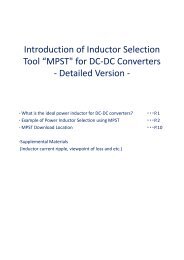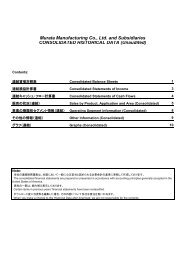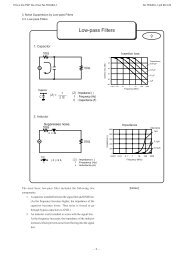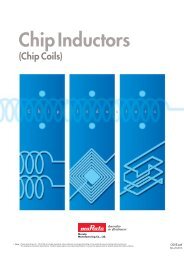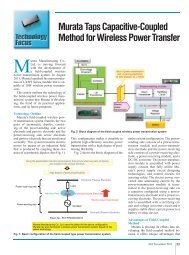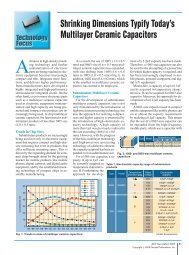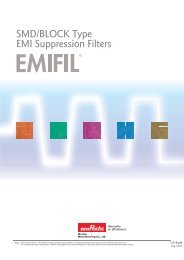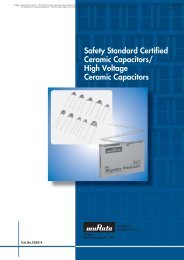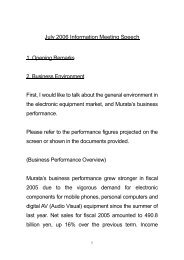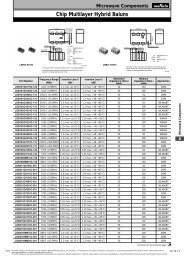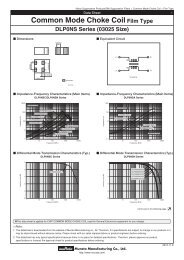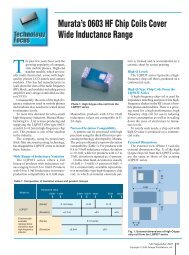Technical guide PDF - Murata
Technical guide PDF - Murata
Technical guide PDF - Murata
You also want an ePaper? Increase the reach of your titles
YUMPU automatically turns print PDFs into web optimized ePapers that Google loves.
Discharge Efficiency from 5.5V to2.0VDischarge efficiency (constant current discharge)Discharge efficiency (constant power discharge)1A 2A 4A 8A 1W 5W 10W 20WDischargeCharge(C)Q 1.21 1.16 1.08 0.93energy(J) 4.58 4.22 3.82 3.11EDischargeefficiency (%)Q/Q 099 95 88 76Dischargeefficiency (%)E/E 0Standard charge (Q 0 ) calculationusing nominal capacitanceQ0=C (Vc-Vt) =0.35 x (5.5-2.0)=1.23(C) E0=2100 92 83 68Standard discharge energy (E 0 ) calculationusing nominal capacitance.1 x C(Vc 2 -Vt 2 ) = 0.5 x 0.35(5.5 2 -2.0 2 )=4.59(J)[2] Effect of temperatureESR of EDLC depends on temperature. When temperature becomes low,ESR becomes high. Therefore, when using EDLC at low temperature,discharge efficiency becomes low. Although <strong>Murata</strong>’s EDLC is designed toprovide stable output throughout a wide range of temperatures, consider energyloss by ESR increase if neededDischarge efficiency data(DMF rated voltage 5.5V, nominal capacitance 330mF, ESR60mΩ)Charge condition: 5.5V 30minDischarge efficiency from 5.5V to 2.0V is shown below in two patterns:Constant current discharge profile and constant power discharge profile.Discharge efficiency at low temperature is lower than at room temperatureESR change400%350%300%250%200%150%100%50%0%-50%-40 -30 -20 -10 0 10 20 30 40 50 60 70 80Temperature [℃ ]< Constant current discharge profile > < Constant power discharge profile >(e.g. DMF series 350mF)(e.g. DMF series 350mF) < Constant power discharge >1A 2A 4A 1W 5W 10WCharge(C) 25℃Discharge1.21 1.16 1.0825℃ 4.58 4.22 3.82energy(J)Q-30℃ 1.01 0.83 0.55 E -30℃ 3.78 2.20 1.56Discharge25℃Discharge99 95 88efficiency (%)efficiency (%)25℃ 100 92 83Q/Q 0 -30℃ 83 68 45 E/E 0 -30℃ 82 48 34Standard charge (Q 0) calculationStandard discharge energy(E 0 ) calculationusing nominal capacitanceusing nominal capacitanceQ 0 =C(Vc-Vt)=0.35 x(5.5-2.0)=1.23(C) E 0 = 1 x C(Vc 2 -Vt 2 ) = 0.5 x 0.35(5.5 2 -2.0 2 )=4.59(J)28




